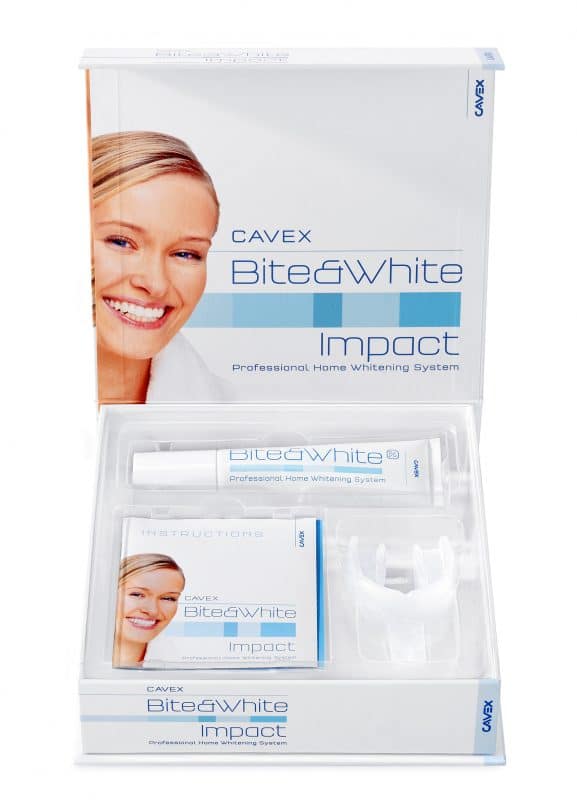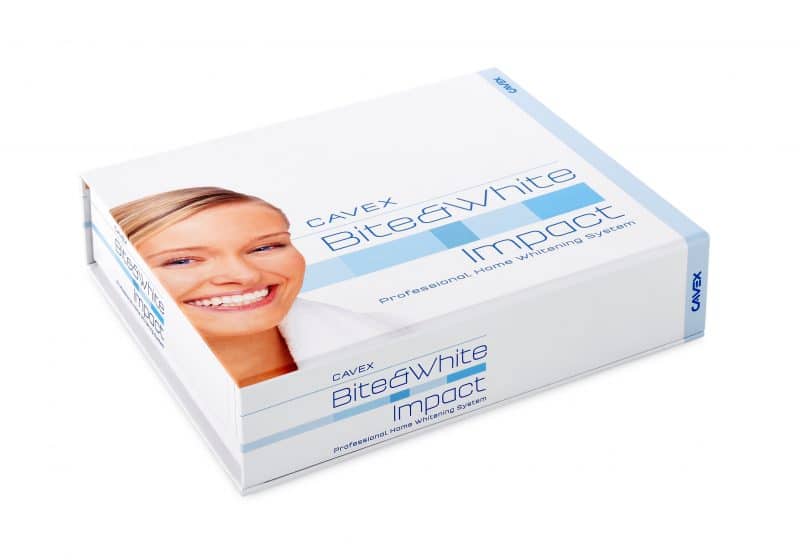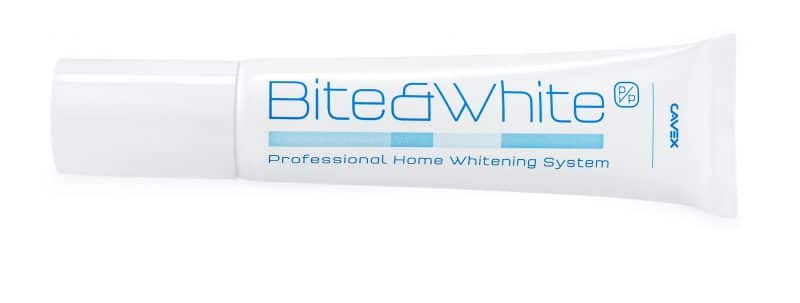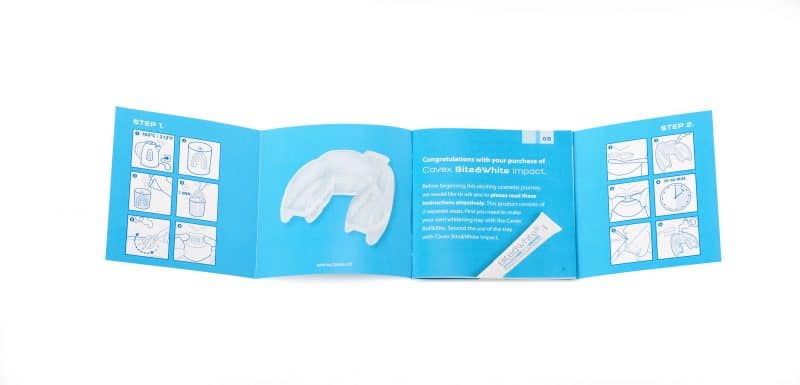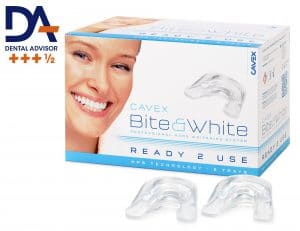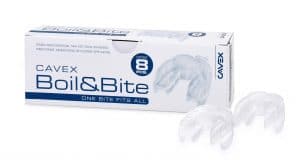Dealers
Users
General
Cavex Bite&White Impact Kit
The revolutionary Cavex Bite&White Impact Kit is a complete do-it-yourself teeth whitening set for use at home. No need for syringes, as the whitening gel is applied using a tube. With the gel being stable at room temperature, the Cavex Bite&White Impact Kit is a one-of-a-kind at-home whitening set.
The tailor-made whitening tray contains enough whitening gel for an additional touch-up. With clear instructions included, this home teeth whitening kit is very user-friendly.
More information about this product? Download the brochure below. Visit our distributor’s page to discover where the product is available.
Features
- Stable at room temperature
- No refrigeration needed
- Thermally deformable whitening tray
- Sufficient whitening gel for potential touch up
- Clear instructions included
Cavex Congress “Whitening shouldn’t be frightening”
In 2017 Cavex gathered the world’s most renowned dental specialist in the field of teeth whitening from all over the world for the congress ‘Whitening shouldn’t be frightening’. During this congress these specialists shared their view on the various available whitening solutions and techniques. Click here to read more.
-
Product Photos
-
Product Videos
-
FAQ
-
Instructions For Use
-
FAQ
-
How does teeth whitening work?
Teeth discoloration can have an intrinsic and/or an extrinsic cause. When the discoloration has an intrinsic cause, it means that there are small cracks in the enamel and dentin. Molecules in these cracks discolor, and that’s what you see. Extrinsic means “from the outside” and these are the stains on the surface of your teeth. The gel used for Cavex Bite&White contains 16% carbamide peroxide. This proven whitening agent is able to penetrate the enamel and break down the discolored molecules by forming radicals (small energy balls). For the stains on the outside “extrinsic” part of the teeth, sometimes a whitening toothpaste can suffice. However, using a whitening gel would bleach both intrinsic and extrinsic discoloration more thoroughly and thus more effectively.
-
Is teeth whitening bad for the teeth?
Teeth whitening should only be done under the supervision of a dentist. Teeth whitening under controlled dental conditions is safe and effective. Clinical studies support the safety and effectiveness of home whitening gels when used appropriately. Tooth sensitivity and irritation to the soft tissues/gums can occur during whitening treatment, but these effects are short-lived. Cavex Bite&White has been developed and produced according to strict European cosmetic legislation and has undergone a thorough test and evaluation.
-
Where can Cavex Bite&White be bought?
In short, at the dentist and the dentist at a dental depot. Cavex Bite&White may only be sold by a dentist. Before the whitening procedure, a consultation with a qualified dentist is recommended to rule out any underlying health conditions. According to the new European Cosmetic Directive 76/768/EEC, teeth whitening products containing between 0.1% and 6% hydrogen peroxide (16% carbamide peroxide) may only be sold by dentists. Higher concentrations may not be sold within Europe.
The purpose of the law is twofold. On the one hand, it is designed to reduce the risk of tooth and gum damage that could result from using a teeth whitening product releasing more than 6% hydrogen peroxide. The law also plans to ensure that all whitening procedures performed with a significant amount of hydrogen peroxide released are supervised by someone with the training and knowledge necessary to ensure that the treatment is performed safely and effectively.
Cavex Bite&White has been developed in full compliance with this European legislation, and Cavex fully supports the enforcement of this law.
-
When is the best time to whiten teeth?
With Cavex‐Bite&White we recommend that you whiten your teeth one and a half hours before going to sleep. Apply the whitening spoons in the mouth, let it act for 1 hour, then remove the whitening spoons from the mouth and rinse the mouth. There is ample time for remineralization after bleaching while sleeping. Immediately after whitening, your teeth are more sensitive to discoloration from foods or drinks. The structure of the teeth is “open”, so eating or drinking products with dyes (red wine, coffee, tea, soft drinks, smoking) that could stain are not recommended. Anything that can stain a white t-shirt can stain the teeth. No foods are consumed while sleeping, so there is no risk of staining.
-
For how long should the bleaching spoon be kept in the mouth?
We recommend holding the whitening spoon in your mouth for half an hour to an hour. The “active ingredient”, in the case of Cavex Bite&White carbamide peroxide, takes about an hour to fully work out.
-
How often should the procedure be repeated?
The starter kit contains two syringes of gel. Both syringes have enough material for 5 days of bleaching, so a total of 10 days of bleaching (upper and lower jaw). If by then the desired result is achieved, great. If not, discuss a possible extension of treatment with your dentist.
-
Can teeth whitening lead to tooth or gum sensitivity?
The well-fitting whitening tray in combination with the thixotropic whitening gel should ensure that the gel does not come into contact with areas prone to irritation such as your gums. Cavex Bite&White contains potassium nitrate in the gel. This is a desensitizer, minimizing sensitivity. Mild sensitivity is possible and varies from person to person. In this case, you may want to use a desensitizer like Cavex ExSense.
-
How much whiter will teeth get?
An exact indication cannot be given, except… the teeth will become whiter! The amount of shades lighter varies too much from person to person. This also depends on the nature and current condition of your teeth, the type of measurements and the motivation (discipline) of the user. If you are not satisfied with the results after 10 days of use, consider using an additional syringe of whitening gel
-
How long can the gel/product be stored?
Like all products, Cavex Bite&White also has an expiration date. Cavex Bite&White can be kept for at least 3 years, provided it is stored in the refrigerator.
-
What is the difference between teeth whitening at the dentist or with the home whitening method?
There are two ways to effectively whiten teeth. One of these is the “quick” practice treatment at a dentist, the other way is whitening at home. In practice, bleaching is usually done with a ‘high peroxide gel’. After the session, the patient’s teeth will have undergone a certain amount of whitening.
-
How should Cavex Bite&White be stored?
Always keep the whitening gel in the refrigerator. This is necessary because high temperatures can lead to activation of the peroxides in the gel, resulting in a less effective and low concentrated gel.
-
Can the teeth still be whitened with restorations / crowns / veneers in the teeth?
Teeth can still be whitened with in-dental restorations, however, these restorations will not be affected by the whitening gel. One solution to this is to replace the restorations after the desired whitening result has been achieved. The patient and dentist always make this decision together.
-
Is teeth whitening safe?
Teeth whitening should only be done under the supervision of a dentist. Teeth whitening under supervised dental supervision is safe and effective. A major reason why many whitening treatments are dangerous for your teeth is the pH level. Many whitening materials have a low pH, and according to the saying “if you want to be beautiful, you have to suffer”. Cavex Bite&White is pH neutral and therefore safe and pain-free to use.Clinical studies support the safety and effectiveness of home bleaching systems when it is pH neutral and used appropriately. Tooth sensitivity and soft tissue irritation can occur during the whitening treatment, but these effects are only short-lived.
-
Does Cavex Bite&White contain fluoride?
Yes, the gel contains fluoride. Fluoride is a proven agent for rapid remineralization and restoration of the micro-hardness of the elements.
-
Are whitening procedures with lamps at a dentist more effective than at home without a lamp?
The claim of a lamp is that the effect of the peroxide is accelerated. However, literature proves no effect of a lamp for accelerating teeth whitening. High intensity of the light can lead to several degrees of temperature rise resulting in faster breakdown of the peroxide. Numerous studies indicate that the faster the bleaching process, the faster discoloration occurs. Also, the heat from the light on the teeth for a long time is potentially dangerous for the pulp in the teeth.
-
Why is 6% hydrogen peroxide the maximum percentage in Europe?
Based on numerous studies, the Scientific Committee on Consumer Products (SCCP) made a safety assessment in 2011 on the use of hydrogen peroxide in oral hygiene and tooth whitening products. As in many risk assessments, the SCCP used the Safety Margin Of Safety (MOS) to determine the maximum concentration that can be considered safe. MOS values less than 100 have been interpreted as unsafe by regulatory authorities.Safety margin = NOAEL (mg/kg body weight/day)Exposure (mg/kg body weight/day)NOAEL for hydrogen peroxide:A 100 day study showed a significant reduction in plasma catalyst level at higher doses. Based on this study, the NOAEL (No‐Adverse‐Effect‐Level) was stated to be 20 mg/kg bw/day. Estimated daily exposure (average 60 kg body weight):Toothpaste = 480 mg/day with 0.1% hydrogen peroxide0.48 mg / 60 = 0.008 mg/kg bw/day MOS = 20/0.008 = 2500 = SAFEMouthwash = 3000 mg/day with 0.1% hydrogen peroxide 3 mg / 60 = 0.05 mg/kg bw/day MOS = 20/0.05 = 400 = SAFETooth whitener = 200mg gel/tray/day with 6% hydrogen peroxide 12 mg / 60 = 0.2 mg/kg bw/day MOS = 20/0.2 = 100 = SAFETooth whitener = 200mg gel/tray/day with 35% hydrogen peroxide 70 mg / 60 = 1.17 mg/kg bw/day MOS = 20/1.17 = 17 = NOT SAFE Conclusion:Based on the MOS evaluation, the SCCP considered 6% hydrogen peroxide (16% carbamide peroxide) to be the maximum allowable concentration. References:SCCP report 18/12/2007– in the file.
-
Why do white spots appear on the tooth(s)?
There could be three things going on.1) Fluorosis. This is one of the reasons why a dentist or a whitening procedure is allowed to start.This could already have been present, but not noticed. Fluorosis is a developmental defect of tooth enamel caused by excessive exposure to high concentrations of fluoride during tooth development, not from the use of whitening products. 2) Started the whitening treatment immediately after removing braces. The braces have caused the enamel to descale and these stains may be more sensitive to the gel. There are ways to remove the stains, in consultation with the dentist. 3) The teeth are dried out. A peroxide gel with too high a percentage has been used for too long and that dries out the teeth. But don’t worry; these spots will disappear after a few days. We call this the “Chicken bone effect”. Let a chicken bone dry for a few days and it will turn white. Put it in water and it will return to its original color. The chances of this happening with moderately dosed whitening gels, such as Cavex Bite&White” are minimal.
-
Why can the mouth foam when the whitening spoon goes into the mouth?
Wanneer dit gebeurt zijn er een paar mogelijke verklaringen.De gebruiker heeft een spalkje in je mond. De peroxide reageert op dit metaal en begint te schuimen. De tandarts moet hierop controleren bij het verstrekken van het tandenbleekmateriaal.Er zijn nog zure vloeistoffen in je mond. De peroxide reageert op zure vloeistoffen, dus probeer dit te vermijden door goed te spoelen na het gebruik van zure mondspoelingen enz.
-
Instructions For Use
-
Assortment
-
Brochures
-
Product info
-
MSDS
-
Cases & Research
| Art. nr. | Description | Contents |
|---|---|---|
| BW040 | Cavex Bite&White Impact Kit | 1x Tube PVP Gel 40 g, 1x Tray, IFU |
-
Product info






